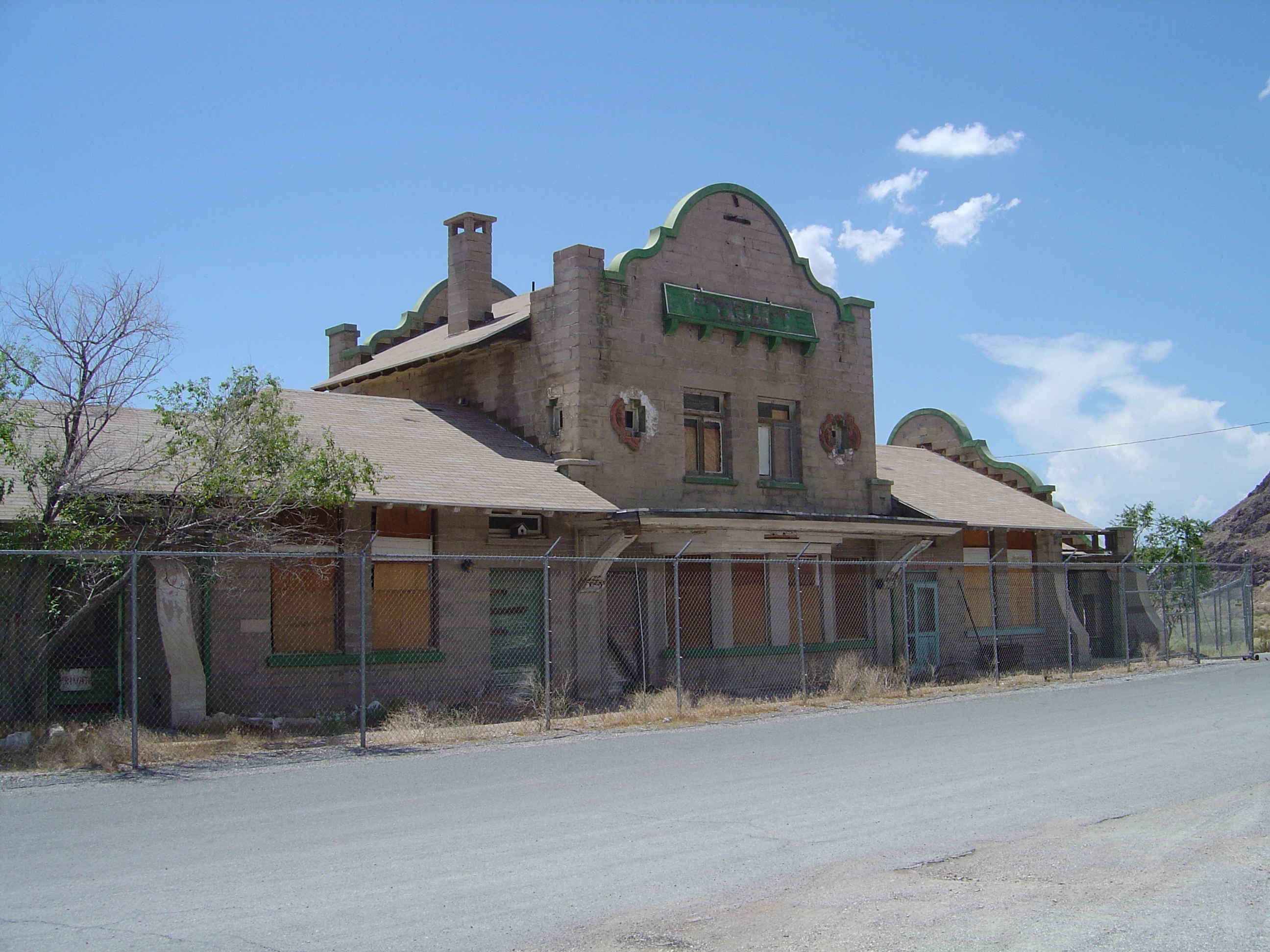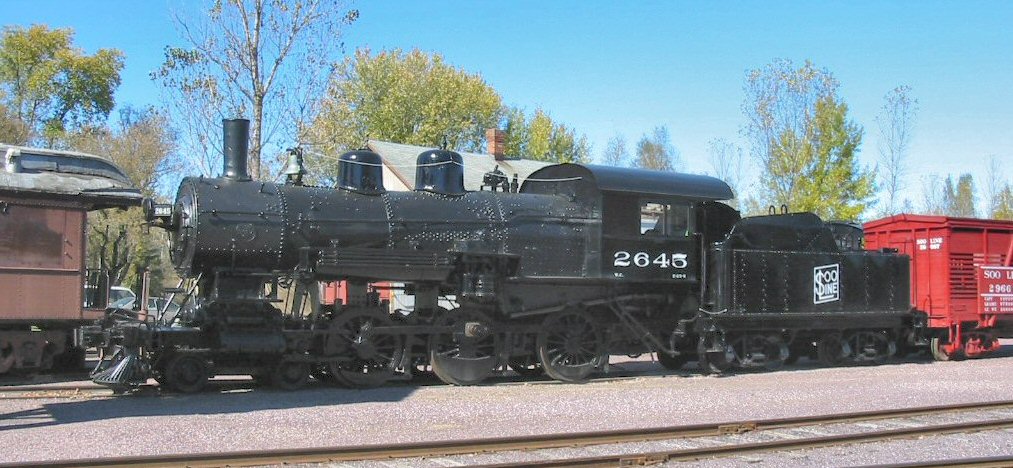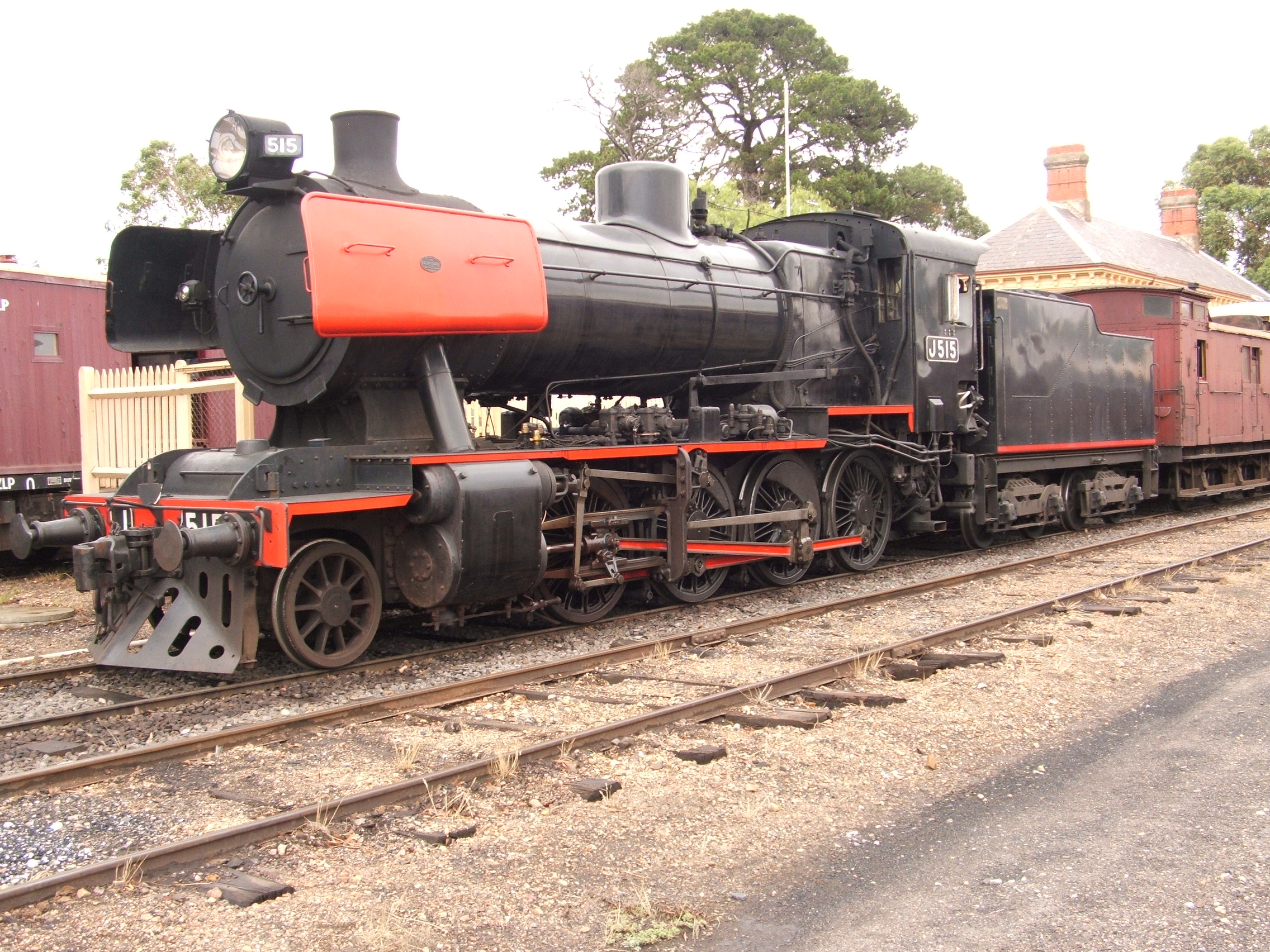|
Las Vegas And Tonopah Railroad
The Las Vegas and Tonopah Railroad was a railroad built by William A. Clark that ran northwest from a connection with the mainline of the San Pedro, Los Angeles and Salt Lake Railroad at Las Vegas, Nevada to the gold mines at Goldfield. The SPLA&SL railroad later became part of the Union Pacific Railroad and serves as their mainline between Los Angeles and Salt Lake City. History In April 1905, Clark made a verbal agreement with Francis Marion Smith that Smith could build a rail line to his borax operations at Lila C connecting with the San Pedro, Los Angeles and Salt Lake Railroad at Las Vegas. After Smith's men had already graded for tracks, his workers received a no trespassing order that they were not allowed to connect with Clark's rail. Clark had apparently changed his mind, and subsequently, he laid his own rail on the line graded by Smith's men. In response, Smith started his own competing railroad, the Tonopah and Tidewater to the Goldfield boomtowns in direct compe ... [...More Info...] [...Related Items...] OR: [Wikipedia] [Google] [Baidu] |
Las Vegas, Nevada
Las Vegas (; Spanish for "The Meadows"), often known simply as Vegas, is the 25th-most populous city in the United States, the most populous city in the state of Nevada, and the county seat of Clark County. The city anchors the Las Vegas Valley metropolitan area and is the largest city within the greater Mojave Desert. Las Vegas is an internationally renowned major resort city, known primarily for its gambling, shopping, fine dining, entertainment, and nightlife. The Las Vegas Valley as a whole serves as the leading financial, commercial, and cultural center for Nevada. The city bills itself as The Entertainment Capital of the World, and is famous for its luxurious and extremely large casino-hotels together with their associated activities. It is a top three destination in the United States for business conventions and a global leader in the hospitality industry, claiming more AAA Five Diamond hotels than any other city in the world. Today, Las Vegas annually ranks as one ... [...More Info...] [...Related Items...] OR: [Wikipedia] [Google] [Baidu] |
Beatty, Nevada
Beatty ( ) is an unincorporated town along the Amargosa River in Nye County in the U.S. state of Nevada. U.S. Route 95 runs through the town, which lies between Tonopah, about to the north and Las Vegas, about to the southeast. State Route 374 connects Beatty to Death Valley National Park, about to the west. Before the arrival of non-indigenous people in the 19th century, the region was home to groups of Western Shoshone. Established in 1905, the community was named after Montillus (Montillion) Murray "Old Man" Beatty, who settled on a ranch in the Oasis Valley in 1896 and became Beatty's first postmaster. With the arrival of the Las Vegas and Tonopah Railroad in 1905, the town became a railway center for the Bullfrog Mining District, including mining towns such as nearby Rhyolite.McCracken, ''History'', pp. 56–59 Starting in the 1940s, Nellis Air Force Base and other federal installations contributed to the town's economy as did tourism related to Death Valley Nationa ... [...More Info...] [...Related Items...] OR: [Wikipedia] [Google] [Baidu] |
Outer Harbor Terminal Railway
{{Short pages monitor ... [...More Info...] [...Related Items...] OR: [Wikipedia] [Google] [Baidu] |
Bullfrog Goldfield Railroad Locomotive Roster
''Bullfrog'' is a common English language term to refer to large, aggressive frogs, regardless of species. Examples of bullfrogs include: Frog species America *Helmeted water toad (''Calyptocephalella gayi''), endemic to Chile *American bullfrog (''Lithobates catesbeianus''), indigenous to North America *Cane toad (''Rhinella marina''), a toad indigenous to Central and South America, called 'bullfrog' in the Philippines Australia *''Limnodynastes dorsalis'', found in Southwest Australia *''Limnodynastes dumerilii'', found in Western Australia *Giant banjo frog (''Limnodynastes interioris''), found in Eastern Australia Africa *African bullfrog (''Pyxicephalus adspersus''), found in central and southern Africa *Calabresi's bullfrog (''Pyxicephalus obbianus''), found in Somalia *Crowned bullfrog (''Hoplobatrachus occipitalis''), found in much of Africa *Edible bullfrog (''Pyxicephalus edulis''), found in much of Africa Asia *Banded bullfrog (''Kaloula pulchra''), found in Southea ... [...More Info...] [...Related Items...] OR: [Wikipedia] [Google] [Baidu] |
0-6-0
Under the Whyte notation for the classification of steam locomotives, represents the wheel arrangement of no leading wheels, six powered and coupled driving wheels on three axles and no trailing wheels. This was the most common wheel arrangement used on both tender and tank locomotives in versions with both inside and outside cylinders. In the United Kingdom, the Whyte notation of wheel arrangement was also often used for the classification of electric and diesel-electric locomotives with side-rod coupled driving wheels. Under the UIC classification, popular in Europe, this wheel arrangement is written as C if the wheels are coupled with rods or gears, or Co if they are independently driven, the latter usually being electric and diesel-electric locomotives. Overview History The 0-6-0 configuration was the most widely used wheel arrangement for both tender and tank steam locomotives. The type was also widely used for diesel switchers (shunters). Because they lack leading a ... [...More Info...] [...Related Items...] OR: [Wikipedia] [Google] [Baidu] |
Bullfrog Goldfield Railroad
The Bullfrog Goldfield Railroad (BGRR) was a railroad lying just inside and about midway of the southwestern State line of Nevada. It was incorporated in 1905 to provide an outlet from the mining section near Beatty to the north over the lines of the Tonopah and Goldfield Railroad and the Southern Pacific Railroad. Track The main line of the Bullfrog Goldfield Railroad Company extended from Beatty in a general north-northwesterly direction to Goldfield. A long branch line, ran westward from Beatty to Rhyolite. The total road mileage owned was thus 84.78 miles. Yard tracks and sidings to an aggregate of brought the total owned mileage to . The Bullfrog Goldfield Railroad Company owned no terminal facilities, as such, but used the station and yard facilities at Beatty belonging to the Las Vegas & Tonopah Railroad Company. Corporate history The Bullfrog Goldfield Railroad Company was incorporated September 1, 1905, under the general laws of Nevada, for a period of 50 ... [...More Info...] [...Related Items...] OR: [Wikipedia] [Google] [Baidu] |
San Diego And Arizona Railway
The San Diego and Arizona Railway was a short line U.S. railroad founded by entrepreneur John D. Spreckels, and dubbed "The Impossible Railroad" by engineers of its day due to the immense logistical challenges involved. It linked San Diego, its western terminus, with El Centro, its eastern terminus, where passengers could connect with Southern Pacific's transcontinental lines, eliminating the need to first travel north via Los Angeles or Riverside. The company charter was executed on December 14, 1906, and the groundbreaking ceremony was held the following September. Numerous delays (including government intervention during World War I) delayed the completion of the line to November 15, 1919. Damage to the lines from both natural disasters and sabotage exerted great financial pressure on the company, and in 1932 Spreckels' heirs sold their interests in the railroad to the Southern Pacific, which was named the San Diego & Arizona Eastern Railway (SD&AE). History The compan ... [...More Info...] [...Related Items...] OR: [Wikipedia] [Google] [Baidu] |
Los Angeles And Salt Lake Railroad
The Los Angeles and Salt Lake Railroad was a rail company in California, Nevada, and Utah in the United States, that completed and operated a railway line between its namesake cities (Salt Lake City, Utah and Los Angeles, California), via Las Vegas, Nevada. Incorporated in Utah in 1901 as the San Pedro, Los Angeles and Salt Lake Railroad, the line was largely the brainchild of William Andrews Clark, a Montana mining baron and United States Senator. Clark enlisted the help of Utah's U.S. Senator Thomas Kearns, mining magnate and newspaper man, to ensure the success of the line through Utah. Construction of the railroad's main line was completed in 1905. Company shareholders adopted the LA&SL name in 1916. The railway was also known by its official nickname, "The Salt Lake Route", and was sometimes informally referred to as "The Clark Road". The tracks are still in use by the modern Union Pacific Railroad, as the Cima, Caliente, Sharp, and Lynndyl Subdivisions. History The deve ... [...More Info...] [...Related Items...] OR: [Wikipedia] [Google] [Baidu] |
Northwestern Pacific Railroad
The Northwestern Pacific Railroad is a regional shortline railroad utilizing a stretch of the 271 mile mainline between Schellville and Windsor with freight and Sonoma–Marin Area Rail Transit (SMART) commuter trains. Formerly, it was a regional railroad primarily used for logging that served the entire North Coast of California, with a main line running from Schellville to Eureka, along with an additional portion of the line running from the Ignacio Wye to the edge of San Rafael. The "Southern End" of the line, including Schellville to Willits and from Ignacio to San Rafael is owned by SMART, while the "Northern End" was formally owned and managed by the now-dissolved North Coast Railroad Authority but is now saved for use in California's 2018 Great Redwood Trail Act, which repurposes the unused railroad right-of-way from Eureka to Willits for future use as the Great Redwood Trail. History In the late 1800s both the Southern Pacific Railroad (“SP”) and the Atchi ... [...More Info...] [...Related Items...] OR: [Wikipedia] [Google] [Baidu] |
Baldwin Locomotive Works
The Baldwin Locomotive Works (BLW) was an American manufacturer of railroad locomotives from 1825 to 1951. Originally located in Philadelphia, it moved to nearby Eddystone, Pennsylvania, in the early 20th century. The company was for decades the world's largest producer of steam locomotives, but struggled to compete as demand switched to diesel locomotives. Baldwin produced the last of its 70,000-plus locomotives in 1951, before merging with the Lima-Hamilton Corporation on September 11, 1951, to form the Baldwin-Lima-Hamilton Corporation. The company has no relation to the E.M. Baldwin and Sons of New South Wales, Australia, a builder of small diesel locomotives for sugar cane railroads. History: 19th century Beginning The Baldwin Locomotive Works had a humble beginning. Matthias W. Baldwin, the founder, was a jeweler and whitesmith, who, in 1825, formed a partnership with machinist David H. Mason, and engaged in the manufacture of bookbinders' tools and cylinders for cal ... [...More Info...] [...Related Items...] OR: [Wikipedia] [Google] [Baidu] |
Brooks Locomotive Works
The Brooks Locomotive Works manufactured railroad steam locomotives and freight cars from 1869 through its merger into the American Locomotive Company (ALCO) in 1901. History When the New York and Erie Railroad (NY&E) relocated its shops facilities from Dunkirk, New York, to Buffalo in 1869, Dunkirk lost its largest employer. Coming to the city's rescue was Horatio G. Brooks (1828–1887), the former chief engineer of the NY&E who was at the controls of the first train into Dunkirk in 1851. In 1869, Brooks leased the Dunkirk shops facility from the NY&E and formed the Brooks Locomotive Works. The new company officially opened on November 13, 1869. The company's first steam locomotive was completed the following month as part of an order for the NY&E, the company's first customer. Within a couple of years of its opening, Brooks was producing as many as seven new locomotives per month, compared to one per month while the facility was controlled by the NY&E. Brooks bui ... [...More Info...] [...Related Items...] OR: [Wikipedia] [Google] [Baidu] |
2-8-0
Under the Whyte notation for the classification of steam locomotives, represents the wheel arrangement of two leading wheels on one axle, usually in a leading truck, eight powered and coupled driving wheels on four axles, and no trailing wheels. In the United States and elsewhere, this wheel arrangement is commonly known as a Consolidation, after the Lehigh and Mahanoy Railroad’s ''Consolidation'', the name of the first 2-8-0.White, John H. Jr. (1968). ''A history of the American locomotive; its development: 1830-1880''. New York: Dover Publications, p. 65. The notation 2-8-0T indicates a tank locomotive of this wheel arrangement, the "T" suffix indicating a locomotive on which the water is carried in side-tanks mounted on the engine rather than in an attached tender. The Consolidation represented a notable advance in locomotive power. After 1875, it became "the most popular type of freight locomotive in the United States and was built in greater quantities than any other si ... [...More Info...] [...Related Items...] OR: [Wikipedia] [Google] [Baidu] |



.jpg)






